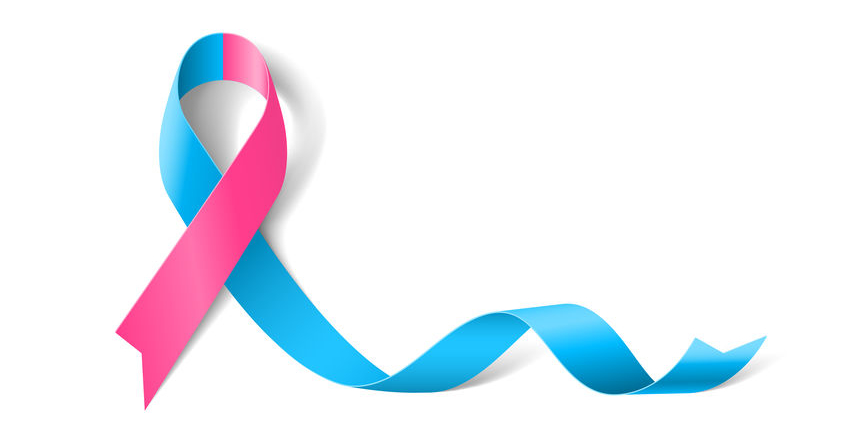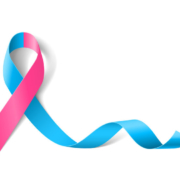21 October 2019
Especially during October, when everything seems to be painted pink, it’s easy to overlook the fact that breast cancer is a disease of women and men. Male breast cancer accounts for 0.6 – 1.0% of all breast cancer cases. In the US, approximately 2600 men will be diagnosed with breast cancer each year. The lifetime risk is about 1 in 1000, versus 1 in 8 for women. Male breast cancer accounts for approximately 500 deaths in the US per year. Risk factors include increasing age, family history including BRCA gene mutations, obesity, alcohol intake, prior chest wall radiation, and low androgen hormone levels.
Male breast cancer tends to be diagnosed in later stages compared with breast cancer in women, and previous studies have come to conflicting conclusions about whether the poorer outcomes are due to higher stage at diagnosis or other factors. A study recently published in JAMA Oncology* looked at mortality rates among men and women diagnosed with breast cancer. The researchers used the National Cancer Database (NCDB) and compared men and women who were diagnosed with breast cancer between January 2004 – December 2014. Their data analysis included approximately 16,000 men and 1.8 million women. Some of the key findings:
- Mean age at diagnosis was 63.3 for men and 59.9 for women
- 3-year survival was 86.4% for men and 91.7% for women
- 5-year survival was 77.6% for men and 86.4% for women
- Overall survival was 45.8% for men and 60.4% for women
Men diagnosed with breast cancer were older, were more likely to be diagnosed at advanced stages, and were less likely to receive conventional therapy. However, differences in survival persisted even after controlling for clinical characteristics of the disease, age, race and ethnicity, and access to care. Limitations of this study are that cause of death could not be determined (so it is not clear if all of the deaths are related to breast cancer) and the NCDB does not contain information on recurrence, BRCA gene status, adherence to treatment recommendations, and other medical conditions. However, the researchers concluded that male sex remained a significant risk factor for poorer outcomes, which suggests that there are biological differences in male versus female breast cancer.
Another study recently published in the journal Cancer* also used NCDB information to look at treatment trends for men treated for breast cancer from a similar time period. The authors evaluated approximately 10,000 cases and noted that:
- 24% underwent breast conserving surgery (lumpectomy)
- 70% of those undergoing lumpectomy received radiation
- 44% of patients received chemotherapy
- 62% of those with estrogen receptor positive (ER+) breast cancer received endocrine therapy
- 35% of those with ER+ / lymph node negative breast cancer had Oncotype Dx testing on their tumor to help determine need for chemotherapy
These findings are consistent with a point made in the JAMA Oncology study noting that men were less likely to receive conventional therapy – for example only 62% with ER+ breast cancer received endocrine therapy and only 70% of those undergoing breast conserving surgery were treated with postoperative radiation therapy. Some of the same limitations apply to this study, in that reasons for differences in therapy could not be determined, and there was no information on disease recurrence.
A few other important points to make about male breast cancer:
- Most male breast cancer presents as a lump, but as in women, most lumps are not cancerous. It is important that a proper evaluation (usually including a mammogram and ultrasound, and possibly biopsy) be performed for any change
- As in women, male breast cancer may present with nipple discharge (especially blood), “puckering” or “pulling in” of the skin, or severe redness of the skin which can be mistaken for infection – the latter may indicate a more aggressive type of breast cancer known as inflammatory breast cancer
- ALL men with breast cancer, and anyone with a family history of male breast cancer, should undergo genetic counseling and testing. As in women, most cases of male breast cancer are “sporadic” (not related to an inherited mutation), but men with breast cancer are more likely to carry deleterious BRCA (especially BRCA 2) mutations
- Men who carry a deleterious BRCA mutation have an approximately 8% lifetime risk (to age 80) of developing breast cancer. So while that is considered “high risk” for men, they are still more likely to NOT develop breast cancer. We do not currently recommend prophylactic mastectomy in men who carry a deleterious BRCA mutation but who have not been diagnosed with breast cancer
- Men who carry a deleterious BRCA mutation are also at higher risk for prostate cancer, melanoma, and pancreatic cancer
Men with breast cancer are usually treated using the same protocols that are used for women. Unfortunately there is limited data to support this. Male breast cancer is not common, so it is challenging to enroll large numbers of patients in clinical trials. However, men have historically been excluded from many breast cancer clinical trials, so how can we even make progress? The US FDA has recently issued draft guidelines encouraging the inclusion of male breast cancer patients in clinical trials – this is certainly a step in the right direction.
*If you are not able to access the full study and would like a copy, please email me: contact at drattai dot com
Additional Information:







